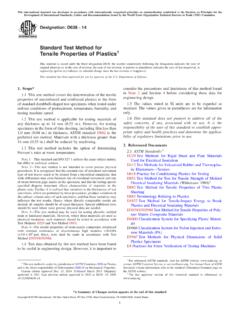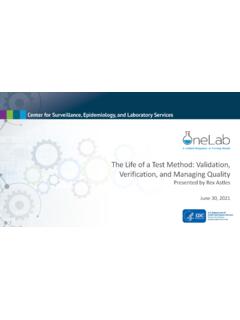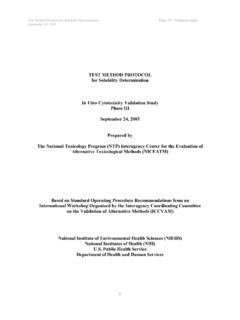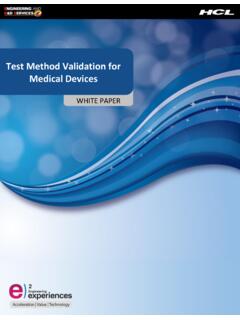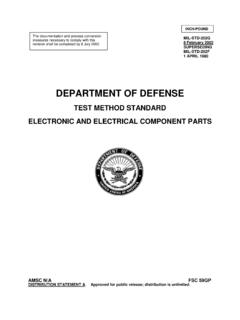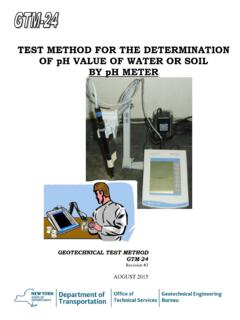Transcription of Test Method Validation and Verification
1 Test Method Validation and Verification All Checklists are 2017. College of American Pathologists. All rights reserved. Page 1 of 9 Excerpts from CAP All Common Checklist, August 21, 2017 release Inspector Instructions: Policies and procedures for the introduction of new tests , methods , or instruments Sampling of assay Validation and Verification studies with emphasis on tests introduced in the past two years, especially high volume tests and tests with the highest risk to patients Sampling of patient reports for laboratory-developed assays Which laboratory tests or instruments have been implemented in the past two years, particularly those that are not FDA-cleared/approved?
2 Do you follow the manufacturer's instructions exactly for all FDA-cleared/approved diagnostic kits or devices? How does your laboratory validate or verify assay performance prior to test implementation? How does your laboratory verify or establish reference intervals? How does your laboratory validate clinical claims made by the laboratory about LDTs? Select at least one Validation or Verification study performed for each type of instrument or Method introduced during the past two years. In addition, select assays for evaluation if recurrent problems have been identified in proficiency testing results, quality control, competency assessment, or physician complaints regardless of how long the assay has been in place.
3 Review Validation or Verification records to confirm that appropriate studies were performed using an adequate number of cases, and data were reviewed. If the data showed discordances or unacceptable variations, investigate how they were resolved. If a study was not performed or is missing required components, cite the appropriate related requirement(s) ( , , ). Confirm that there is a written assessment of each component (accuracy, precision, interferences, etc.) of the Validation or Verification studies with laboratory director (or qualified designee) approval prior to the initiation of clinical testing.
4 If the study assessment was not signed by the laboratory director or designee, cite **NEW** 08/17/2016 Waived Test Implementation and Approval Phase II For each waived test, the laboratory follows manufacturer's instructions for the introduction of the instrument or device and there are records that the test(s) is approved for use by the laboratory director, or designee meeting CAP director qualifications, prior to use in patient testing. NOTE: Waived testing must be performed following the manufacturer's instructions as written. If the laboratory modifies a waived test, the checklist requirements for high complexity testing apply, including the requirements for Validation of the Method performance specifications.
5 The laboratory director's signature on the written test procedure may be used to show approval of the test for use in patient testing. Evidence of Compliance: Records of test approval **REVISED** 08/21/2017 Method Validation and Verification Approval - Nonwaived tests Phase II For each nonwaived test, there is an evaluation of the test Method Validation or Verification study (accuracy, precision, etc.) signed by the laboratory director, or designee meeting CAP director qualifications, prior to use in patient testing to confirm the acceptability of the data and approve each nonwaived test for clinical use.
6 NOTE: This checklist requirement is applicable only to nonwaived tests implemented after June Test Method Validation and Verification All Checklists are 2017. College of American Pathologists. All rights reserved. Page 2 of 9 15, 2009; however, all nonwaived tests must have records of completed analytical Validation or Verification , regardless of their implementation date. If multiple identical instruments or devices are in use, there must be records showing that the Method performance specifications have been separately verified for each test and instrument or device. The evaluation and data must clearly support the decision to approve the test for clinical use.
7 The evaluation must include: 1) a written assessment of each component of the Validation or Verification study, including the acceptability of the data; 2) a signed approval statement, such as, "I have reviewed the Verification (or Validation ) data for accuracy, precision, reportable range, and reference interval studies (insert other components, as required) for the (insert instrument/ test name), and the performance of the Method is considered acceptable for patient testing." If data include discordant results, there must be a record of the discordance and investigation of any impact on the approval of the test for clinical use.
8 If a Validation or Verification study (accuracy, precision, reportable range, etc.) was not performed or is missing required components, the appropriate, related checklist requirements must also be cited ( , , ). For an FDA-cleared/approved test, an evaluation of the Verification data must address analytical performance specifications, including analytical accuracy, precision, interferences, and reportable range, as applicable. In addition, for modified FDA-cleared/approved tests or LDTs, the evaluation must address analytical sensitivity, analytical specificity, and any other parameter that is considered important, to assure the analytical performance of a test ( specimen stability, reagent stability, linearity, carryover, and cross-contamination, etc.)
9 As appropriate and applicable). If the laboratory makes clinical claims about its tests , the evaluation must address the Validation of these claims. See the Method Performance Specifications section for details concerning Validation and Verification . Evidence of Compliance: Evaluation of Validation and Verification studies with review and approval Method Performance Specifications - Nonwaived tests NOTE: This subsection on Method PERFORMANCE SPECIFICATIONS does not apply to waived tests . ANALYTICAL Validation / Verification Laboratories are required to perform analytical Validation or Verification of each nonwaived test, Method , or instrument system before use in patient testing, regardless of when it was first introduced by the laboratory, including instruments of the same make and model and temporary replacement (loaner) instruments.
10 There is no exception for analytical Validation or Verification of tests introduced prior to a specific date. The laboratory must have data for the Validation or Verification of the applicable Method performance specifications and retain the records as long as the Method is in use and for at least two years after discontinuation. The Method performance specifications ( accuracy, precision, reportable range) must be validated or verified in the location in which patient testing will be performed. If an instrument is moved, the laboratory is responsible for determining that the Method performance specifications are not affected by the relocation process or any changes due to the new environment ( refer to the manufacturer's manual regarding critical requirements, such as set-up limitations, environmental conditions, etc.)


